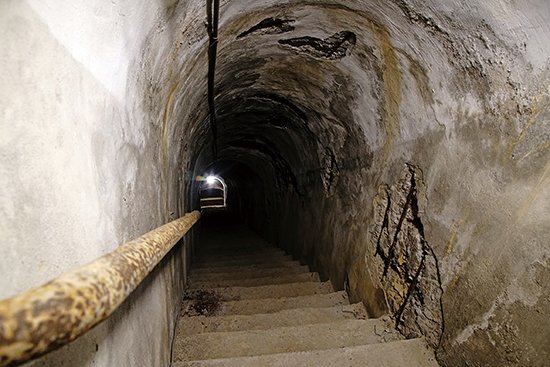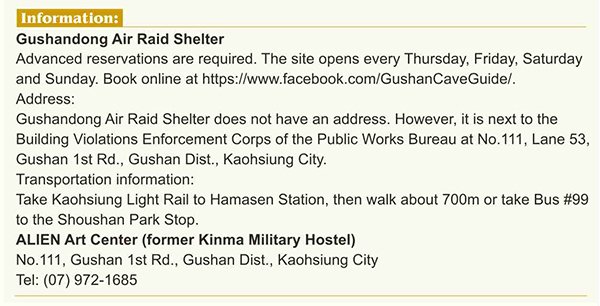※Gushandong Air Raid Shelter
During the Japanese colonial period, the Hamasen neighborhood in Kaohsiung's Gushan District housed a major Japanese headquarters. In World War II, when the US Army Air Forces bombed the area heavily, numerous blockhouses and air-raid shelters were built around Shoushan (Mt. Shou), Cihou Mountain (on Cijin Island), Mt. Guei (in Zuoying District), Mt. Banping (between Zuoying and Nanzih districts), Taidi Mountain in what is now Taidishan Natural Park (in Mituo District), and both Mt. Dagang and Mt. Siaogang in Gangshan District.
 More than 200 air-raid shelters are still extant in Kaohsiung, including over 50 on the slopes of Shoushan. These now draw curious visitors and have become an unexpected tourist attraction.
This May, Kaohsiung City Government opened Gushandong Air Raid Shelter to the public. The shelter, which was built in 1939, has two main tunnels and is around 200m long. The tunnels are about 2.8m high and 3m wide. The entrance is at Gushan Police Station, near where hikers begin climbing Shoushan.
Japan's rule of Taiwan came to an end in 1945 following the country's defeat in World War II. The Nanjing-based ROC (Republic of China) government took control of Taiwan. The ROC government later used Gushandong Air Raid Shelter as a detention facility operated by Taiwan Garrison Command.
A 64-step escape stairway connects the shelter to Shoushan. Because Shoushan is formed of coral limestone, the steps have gradually become covered with stalactites. Gushandong's stalactite stairs are a spellbinding sight.
※ALIEN Art Center (former Kinma Military Hostel)
Built in 1967, Kinma Military Hostel in Gushan District served as a stopover for soldiers heading to frontline islands such as Penghu and Kinmen. The hostel is the only facility of its kind in Taiwan, and it stands as a witness to society's collective story over the past half century. The city government and the private sector have collaborated to achieve a preservation-based revitalization project. The former hostel has been transformed into ALIEN Art Center.
 The restoration preserves key military architectural features, including the iron fence, military coding, iron ladders, square tiles, and terrazzo-mix tiles. At the same time, the center has aqcuired a pristine and contemporary look.
"We endeavored to retain the original military architecture. We engaged artisans to repair the damaged terrazzo-mix tiles. The wall behind the staircase is composed of creamy-while colored tiles. Since these particular tiles are no longer produced in Taiwan, we imported some from Southeast Asia. If you scrutinize the tiles, you can distinguish between the old and the new due to slightly different colors. Time has bestowed marks which add beauty to the architecture," explains Ms. Shao Ya-man, CEO of ALIEN Art Center.
The art center offers modern-art exhibitions, plus a permanent exhibition and an archive room. It is a wonderful space where one can immerse oneself in modern art. The Archive Room displays letters, photos, videos, and oral-history documents.
 |